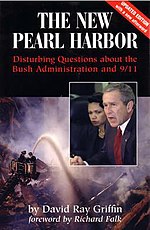The New Pearl Harbor: Difference between revisions
m Robot - Moving category 9/11 conspiracy theories to Alternative theories of the September 11 attacks per CFD at Wikipedia:Categories_for_discussion/Log/2008_August_2#Category:Alternative_theories_of_September_11,_2001_attacks. |
|||
| Line 51: | Line 51: | ||
[[Category:2004 books]] |
[[Category:2004 books]] |
||
[[Category:Current affairs books]] |
[[Category:Current affairs books]] |
||
| ⚫ | |||
[[Category:Alternative theories of the September 11 attacks]] |
|||
[[Category:Alternative theories of the September 11 attacks]] |
[[Category:Alternative theories of the September 11 attacks]] |
||
| ⚫ | |||
Revision as of 15:37, 8 February 2009

Template:911tm The New Pearl Harbor: Disturbing Questions About the Bush Administration and 9-11 (2004, ISBN 1-56656-552-9) is a book written by David Ray Griffin, a retired professor of philosophy at the Claremont School of Theology. It draws analogies between the September 11, 2001 attacks and the attack on Pearl Harbor in 1941. The title is taken from the 2000 paper "Rebuilding America's Defenses" produced by the Project for the New American Century, which noted that only a "new Pearl Harbor" would enable the military and defense policy transformations the group desired to rapidly take place.[1] Many critics of the official story of 9/11 believe the sentence was a prediction of, or a declaration of intent to carry out, the attacks.[2]
The book was included in the official selection of 99 books made available to all members of the the 9/11 Commission.[3]
Content
In the book Griffin presents pieces of evidence and arguments which he believes support a conclusion that the George W. Bush administration was complicit in the September 11, 2001 attacks. Griffin also cites and analyzes the claims of others who believe the collapse of the World Trade Center was a controlled demolition, an assertion which some[weasel words] engineers deny [citation needed]. Although Griffin previously cited researchers claiming American Airlines Flight 77 did not hit the Pentagon, his focus in the book is on the alleged demolition of the World Trade Center.
Part One of the book looks at the events of 9/11, discussing each Flight in turn and also the behaviour of President George W. Bush and his Secret Service protection. Part Two examines 9/11 in a wider context, in the form of four "disturbing questions":
- Did US Officials have advance information about 9/11?
- Did US Officials obstruct investigations prior to 9/11?
- Did US Officials have reasons for allowing 9/11?
- Did US Officials block captures and investigations after 9/11?
One of his conclusions is that the testimony of Norman Mineta, given before the 9/11 Commission, but omitted from their report, is in stark contradiction to the testimony of Vice president Dick Cheney.
The second edition of The New Pearl Harbor contains additional material on the Saudi Arabian hijackers, Sibel Edmonds, his analysis of the official 9/11 Commission set up by the US government, and his belief that the US Government deliberately changed its standard rules for analyzing military intelligence in order to allow the attacks.
Griffin would subsequently publish The 9/11 Commission Report: Omissions And Distortions, which alleged serious problems with the 9/11 Commission Report's version of events.
Critical response
Critics of the book argue that many of the claims in the book are easily refuted, and that there are many leaps of logic.[4] Griffin rejects such criticisms [5] and has debated his critics.[6]
According to former Central Intelligence Agency (CIA) agent Robert Baer, writing in The Nation magazine:
- "What's notable about Griffin's take on these events is how easily he leaps to larger evils, a conspiracy at the top. Griffin is a thoughtful, well-informed theologian who before September 11 probably would not have gone anywhere near a conspiracy theory. But the catastrophic failures of that awful day are so implausible and the lies about Iraq so blatant, he feels he has no choice but to recycle some of the wilder conspiracy theories, several of which were popularized by Thierry Meyssan in L'Effroyable Imposture (9/11: The Big Lie), a bestseller in France. [7].
Baer adds that Griffin's subtitle, Disturbing Questions About the Bush Administration and 9/11, "suggests this book is a search for truth, but don't let that fool you. His mind is all but made up."
Baer, who later changed his mind about the official NIST explanation for 911, added in an Amazon.com editorial review of the Griffin's subsequent book, "Debunking 9/11 Debunking: An Answer to Popular Mechanics and Other Defenders of the Official Conspiracy Theory:"
"Until we get a complete, honest, transparent investigation--not one based on 'confession' extracted by torture--we will never know what happened on 9/11. David Griffin will never let this go until we get the truth." [8]
Howard Zinn, the author of A People's History of the United States, calls The New Pearl Harbor, "the most persuasive argument I have seen for further investigation on the Bush administration's relationship to that historic and troubling event."[9]
In August 2007, National Medal of Science winner Dr. Lynn Margulis praised The New Pearl Harbor and The 9/11 Commission Report: Omissions and Distortions, saying they provide “overwhelming evidence that the official story is contradictory, incomplete, and unbelievable”, while calling for a new investigation.
